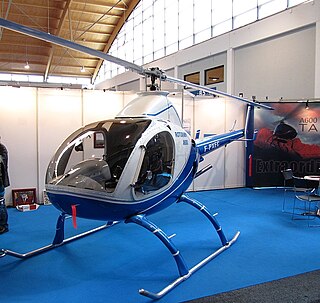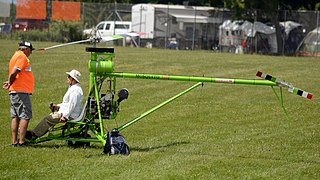Related Research Articles

The Fairey Jet Gyrodyne is a British experimental compound gyroplane built by the Fairey Aviation Company that incorporated helicopter, gyrodyne and autogyro characteristics. The Jet Gyrodyne was the subject of a Ministry of Supply (MoS) research contract to gather data for the follow-up design, the Rotodyne.

The Cessna CH-1 Skyhook is the only helicopter ever built by the Cessna Aircraft Company. It was the first helicopter to land on the summit of Pike's Peak and the last piston-engined helicopter to set the helicopter altitude record. The CH-1 had a single, two-bladed main rotor, and a front-mounted reciprocating engine which gave the aircraft a stable center of gravity (CG). Its semi-monocoque airframe greatly resembles its light airplane siblings built by Cessna. The CH-1 was named Skyhook for the civil market, similar to the marketing names used in the Cessna single engine airplane line, such as Skyhawk, Skylane and Skywagon. The United States Army designated the CH-1C as the YH-41 Seneca. While the CH-1 achieved several helicopter firsts and set a world record, it never became a commercial or military success.

The Kellett XR-10 was a military transport helicopter developed in the United States in the 1940s that only flew in prototype form. It was designed in response to a USAAF Technical Instruction issued for the development of a helicopter to transport passengers, cargo, or wounded personnel within an enclosed fuselage. Kellett's proposal followed the general layout that the company was developing in the XR-8, with twin intermeshing rotors, and was accepted by the Air Force on 16 October over proposals by Sikorsky, Bell, and Platt-LePage.
The Goodyear GA-400R Gizmo was a one-man helicopter proposed for duties such as liaison and observation.
The GEN H-4 is a Japanese helicopter under development by GEN Corporation of Nagano. The aircraft is intended to be supplied as a kit for amateur construction.
The Kinney HRH is an American helicopter that was designed by Robert Kinney and produced by Vortech, Inc in the form of plans for amateur construction. The aircraft was first shown at Sun 'n Fun in 2002.
The Phoenix Skyblazer is an American helicopter that was designed by the Nolan brothers and produced by Phoenix Rotorcraft of Fallston, Maryland and more recently Louisburg, North Carolina. When it was available the aircraft was supplied as a complete ready-to-fly-aircraft.

The RotorWay A600 Talon is an American helicopter, designed and produced by RotorWay International of Chandler, Arizona. The aircraft is supplied as a kit for amateur construction.

The Solution F/Chretien Helicopter is a coaxial electric helicopter prototype designed and built by Pascal Chretien for the Solution F company in France. The aircraft is intended to be a demonstration and exploration of several key electrical power technologies for use in future hybrid helicopters. The helicopter is the first all electric helicopter to hover out of ground effect and set a Guinness World Record on August 12, 2011. It received an IDTechEx Electric Vehicles Land Sea & Air award in 2012.
The LCA LH 212 Delta is a two-seat Italian piston engine ultralight helicopter first flown in 2010.
The American Sportscopter Ultrasport 331 is an American helicopter that was designed and produced by American Sportscopter of Newport News, Virginia. Now out of production, when it was available the aircraft was supplied as a kit for amateur construction.
The American Sportscopter Ultrasport 496 is an American helicopter that was designed and produced by American Sportscopter of Newport News, Virginia. Now out of production, when it was available the aircraft was supplied as a kit for amateur construction.

The Eagle's Perch was an American helicopter that was designed by the Nolan brothers and produced by Eagle's Perch Inc. of Carrollton, Virginia. Now out of production, when it was available the aircraft was supplied as a kit for amateur construction.

The Pawnee Warrior was an American helicopter that was designed and produced by Pawnee Aviation of Longmont, Colorado. Now out of production, when it was available the aircraft was supplied as a kit for amateur construction.
Pawnee Aviation was an American aircraft manufacturer initially based in Longmont, Colorado and later in McCook, Nebraska. The company was founded in the mid-1990s by Ron Willocks and specialized in the design and manufacture of helicopters in the form of kits for amateur construction.

The Dynali H3 EasyFlyer, now known as the Sport, is a Belgian helicopter designed and produced by the Dynali of the Thines district of Nivelles. The aircraft is supplied complete and ready-to-fly-aircraft or as a kit for amateur construction.

The Hungaro Copter is a Hungarian helicopter produced by Hungaro Copter Limited of Verpelét, an affiliate of the Hungarian SteelRiders company. The lead engineer for the design was Zoltán Juhász. The aircraft is supplied as a kit for amateur construction.

The Innovator Mosquito Air is a Canadian helicopter produced by Innovator Technologies of Rockyview, Alberta. The aircraft is supplied as a kit for amateur construction.

The Youngcopter Neo (transl. New) is a German NOTAR helicopter that was designed by Björn Jung and is under development by his company, Youngcopter of Mainz. It was first publicly introduced at the ILA Berlin Air Show in 2008. The aircraft is intended to be supplied as a kit for amateur construction.
The McDonnell 120 Flying Crane, also V-1 Jeep, was a lightweight utility flying crane helicopter designed and built by the McDonnell Aircraft Corporation during the 1950s. The open frame fuselage supported the three gas-producers and main rotor mast, with a small single-seat cockpit in the nose, which was originally open, but later enclosed.
References
- 1 2 3 4 "Pawnee Aviation's Chief Completes First Hover Tests". Aero News Network. December 16, 2005. Retrieved April 2, 2015.
- 1 2 "What happened to the "Warrior" helicopter?". Pawnee Aviation. Archived from the original on October 13, 2002. Retrieved April 2, 2015.
- 1 2 3 "Welcome to the Pawnee Aviation Web Site - Home of the Chief Helicopter Kit". Pawnee Aviation. Archived from the original on February 12, 2008. Retrieved April 2, 2015.
- 1 2 3 "Chief Specifications". Pawnee Aviation. Archived from the original on February 22, 2006. Retrieved April 2, 2015.
- ↑ "Pawnee Aviation". Internet Archive Wayback Machine. June 23, 2013. Retrieved April 2, 2015.
- ↑ "Make / Model Inquiry Results". Federal Aviation Administration. April 2, 2015. Retrieved April 2, 2015.
- ↑ "CHI06LA273". National Transportation Safety Board. September 28, 2006. Retrieved April 2, 2015.